Spoonbills, with their distinctive spoon-shaped bills, captivate the avian world with a unique charm and elegance. There are six notable types of spoonbills, each contributing its flair to wetland ecosystems across the globe.
From the enchanting Yellow-Billed Spoonbill in Australia and New Zealand to the regal Royal Spoonbill gracing the wetlands of Australia, New Zealand, and Southeast Asia, these wading birds embody both resilience and fragility.
The vibrantly rosy Roseate Spoonbill, found in the Americas, adds a splash of color to coastal habitats. Meanwhile, the African Spoonbill, Eurasian Spoonbill, and Black-faced Spoonbill exhibit their distinctive features in various regions.
As we delve into the characteristics and lifestyles of these spoonbill species, we unravel a fascinating tapestry of avian diversity, emphasizing the vital role they play in maintaining ecological balance in their respective habitats.
General Characteristics of Spoonbills
Spoonbills are a group of wading birds known for their distinctive spoon-shaped bills. While there are several species of spoonbills, some of the general characteristics shared by many members of this family include:
Distinctive Bill
The most prominent feature of spoonbills is their unique bill, which is long, flat, and spoon-shaped. The bill is sensitive and adapted for filtering food from the water.
Plumage
Spoonbills typically have white plumage, sometimes with a rosy or pinkish tint, especially on the wings and face. The intensity of the pink coloration can vary based on factors such as diet and age.
Long Legs and Wing Span
They have long legs, which are useful for wading in shallow waters. The legs are often pink or orange. Spoonbills usually have a wide wingspan, which aids in their flight and makes them agile in the air.
Social Behavior
Spoonbills are often found in colonies, especially during the breeding season. They may nest in trees, reed beds, or on the ground, depending on the species.
Habitat
Spoonbills are typically found in wetlands, marshes, mudflats, and shallow coastal waters. They prefer areas with abundant food resources such as small fish, invertebrates, and aquatic plants.
Feeding Habits
Spoonbills are filter feeders, using their specialized bills to sweep through the water and mud to capture prey. They primarily feed on small aquatic organisms, such as fish, insects, crustaceans, and mollusks.
Flight
Spoonbills are strong fliers and often travel long distances during migration. They have a distinctive appearance in flight, with their long necks and legs extended and their bills held out straight.
Breeding
Spoonbills usually breed in colonies, where they build nests on the ground or in trees. They lay a small number of eggs, and both parents are involved in incubating the eggs and caring for the chicks.
Global Distribution
Spoonbills are found on every continent except Antarctica. Some well-known species include the Roseate Spoonbill (found in the Americas), the Eurasian Spoonbill (Europe, Asia, and Africa), and the Black-faced Spoonbill (East Asia).
It’s important to note that there are several species of spoonbills, and while they share these general characteristics, there can be variations in size, coloration, and behavior among different species.
6 Types of Spoonbills
There are six recognized species of spoonbills, a group of large, long-legged wading birds belonging to the family Threskiornithidae. These birds are notable for their distinctive spoon-shaped bills, which they use to forage in shallow waters. Here are the six types:
1. African Spoonbill (Platalea alba)
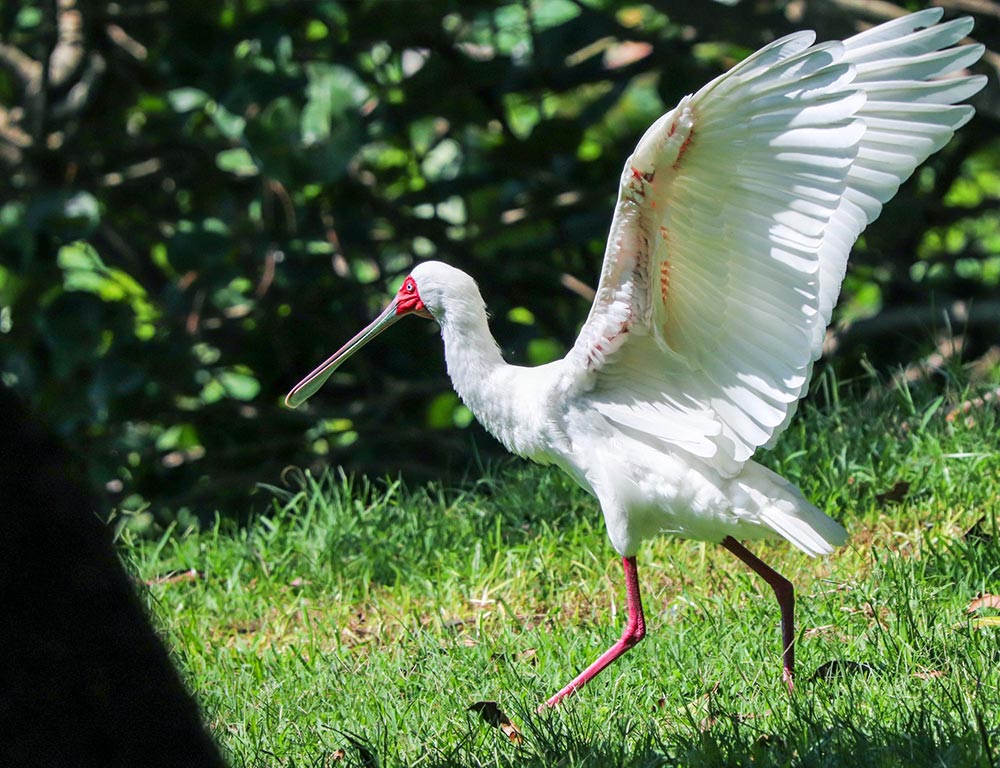
- Scientific Name: Platalea alba
- Category: Wading Bird
- Population: The population is relatively stable, but specific numbers may vary across regions.
- Life Span: Approximately 15-20 years.
- Size: Around 80 to 90 cm in length.
- Weight: Typically between 1.2 to 2 kg.
- Food: Primarily feeds on small fish, insects, crustaceans, and amphibians.
- Wingspan: Approximately 120 to 130 cm.
- Status: Generally considered a species of Least Concern.
The African Spoonbill, scientifically known as Platalea alba, is a graceful wading bird inhabiting the wetlands and shallow waters of sub-Saharan Africa.
With its distinctive spoon-shaped bill, this bird elegantly forages for food, capturing small fish, insects, and crustaceans.
Often found in colonies, especially during the breeding season, African Spoonbills build nests in trees or on the ground. Their relatively stable population and adaptability contribute to their status as a species of Least Concern.
These birds exhibit a lifespan of around 15 to 20 years, with a size ranging from 80 to 90 cm and a weight between 1.2 to 2 kg. Their impressive wingspan, spanning approximately 120 to 130 cm, aids in their graceful flight across their varied habitats.
2. Black-Faced Spoonbill (Platalea minor)
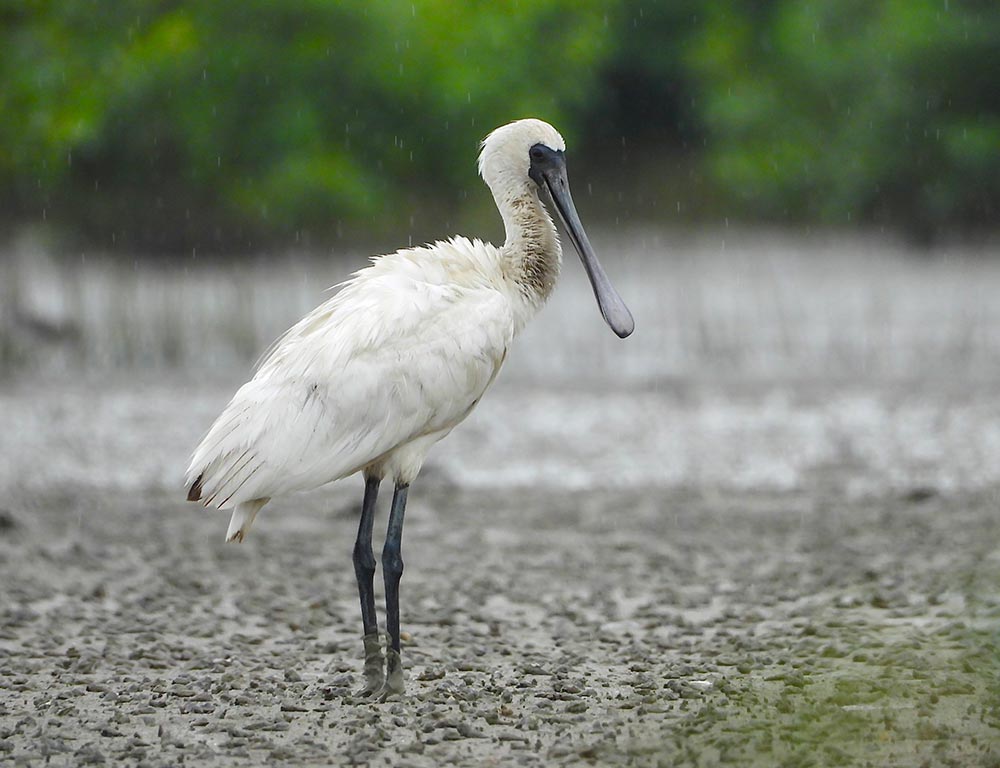
- Scientific Name: Platalea minor
- Category: Wading Bird
- Population: The population is limited, with conservation efforts in place.
- Life Span: Approximately 20 years.
- Size: Approximately 68 to 94 cm in length.
- Weight: Typically between 1.6 to 2.5 kg.
- Food: Mainly consumes small fish, crustaceans, and aquatic invertebrates.
- Wingspan: Around 120 to 140 cm.
- Status: Considered endangered.
The Black-faced Spoonbill, scientifically named Platalea minor, is an intriguing wading bird primarily found in East Asia.
Distinguished by its black facial markings and spoon-shaped bill, this species faces conservation challenges, classified as endangered due to its limited population.
With a lifespan of around 20 years, these birds typically measure between 68 to 94 cm and weigh between 1.6 to 2.5 kg.
They prefer coastal habitats, where they forage for small fish, crustaceans, and aquatic invertebrates. During the breeding season, Black-faced Spoonbills form colonies, exhibiting social behavior in their nesting sites.
The impressive wingspan of 120 to 140 cm enhances their flight capabilities, facilitating their migration between breeding and wintering grounds.
3. Eurasian Spoonbill (Common Spoonbill)
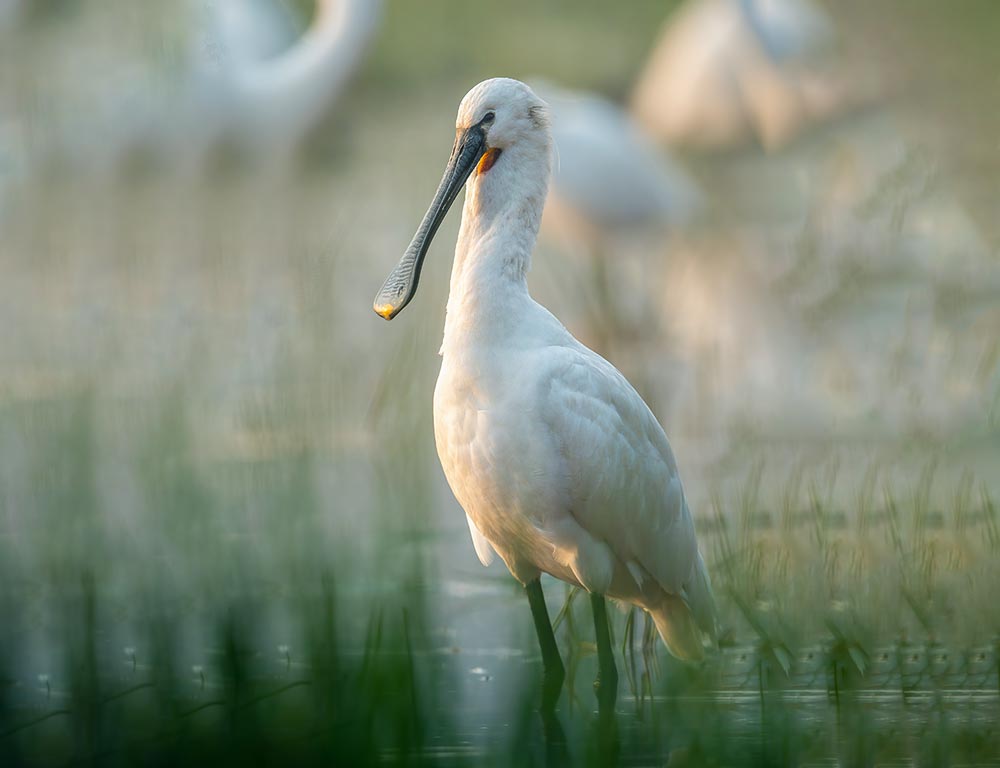
- Scientific Name: Platalea leucorodia
- Category: Wading Bird
- Population: Generally stable with regional fluctuations.
- Life Span: Approximately 10-15 years.
- Size: Typically 80 to 95 cm in length.
- Weight: Around 1.5 to 2.5 kg.
- Food: Feeds on small fish, insects, and aquatic invertebrates.
- Wingspan: Approximately 120 to 150 cm.
- Status: Varies regionally, with some populations listed as Least Concern and others as Near Threatened.
The Eurasian Spoonbill, also known as the Common Spoonbill and scientifically termed Platalea leucorodia, is a widespread wading bird found in Europe, Asia, and Africa.
With its distinctive spoon-shaped bill, this species exhibits a generally stable population, though some regional variations may exist, leading to different conservation statuses.
These birds have a lifespan of approximately 10 to 15 years and typically measure between 80 to 95 cm, weighing around 1.5 to 2.5 kg.
Eurasian Spoonbills are versatile in their habitat choices, frequenting wetlands, marshes, and coastal areas where they forage for small fish, insects, and aquatic invertebrates. Their wingspan, ranging from 120 to 150 cm, facilitates efficient flight during their migrations.
The regional status of this species highlights the importance of conservation efforts to ensure the continued well-being of Eurasian Spoonbills across their diverse range.
4. Yellow-Billed Spoonbill (Platalea flavipes)

- Scientific Name: Platalea flavipes
- Category: Wading Bird
- Population: The population is considered stable.
- Life Span: Around 20 years.
- Size: Typically 80 to 90 cm in length.
- Weight: Approximately 1.2 to 2 kg.
- Food: Feeds on small fish, insects, crustaceans, and aquatic invertebrates.
- Wingspan: Around 120 to 130 cm.
- Status: Generally not of concern.
The Yellow-Billed Spoonbill, scientifically known as Platalea flavipes, is a charming wading bird inhabiting the wetlands and coastal areas of Australia and New Zealand.
Recognizable by its distinct yellow spoon-shaped bill, this species enjoys a stable population, with a lifespan of approximately 20 years. These birds measure between 80 to 90 cm in length and typically weigh between 1.2 to 2 kg.
Yellow-Billed Spoonbills are skilled foragers, capturing small fish, insects, crustaceans, and aquatic invertebrates with their specialized bills. Their wingspan, ranging from 120 to 130 cm, aids in their graceful flight across diverse habitats.
Considered not of concern in terms of conservation, these spoonbills contribute to the biodiversity of their ecosystems, adding a touch of elegance with their unique appearance and feeding behaviors.
5. Royal Spoonbill (Black-Billed Spoonbill)
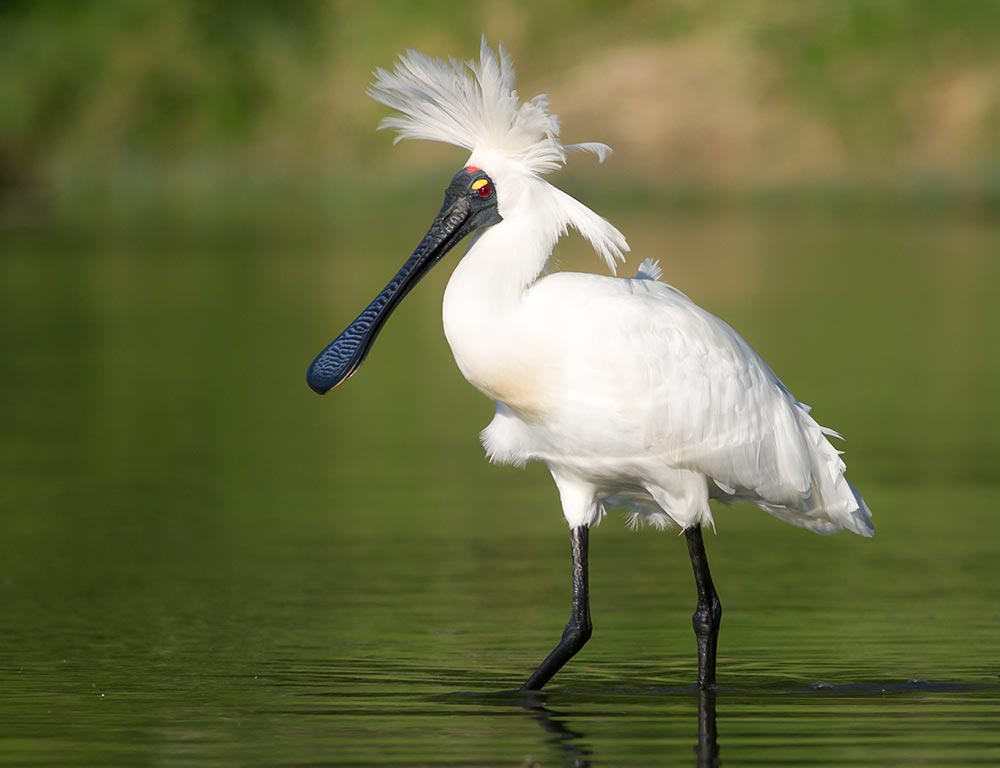
- Scientific Name: Platalea regia
- Category: Wading Bird
- Population: Generally stable, with regional variations.
- Life Span: Around 20 years.
- Size: Typically 80 to 90 cm in length.
- Weight: Approximately 1.2 to 2.7 kg.
- Food: Primarily feeds on small fish, crustaceans, and insects.
- Wingspan: Around 120 to 140 cm.
- Status: Conservation status varies, with some populations listed as Least Concern and others as Near Threatened.
The Royal Spoonbill, scientifically referred to as Platalea regia or Black-Billed Spoonbill, is a distinctive wading bird found in Australia, New Zealand, and some parts of Southeast Asia.
With a stable population overall, regional variations in conservation status exist, with some populations listed as Least Concern and others as Near Threatened.
These birds boast a lifespan of around 20 years and typically measure between 80 to 90 cm, with a weight ranging from 1.2 to 2.7 kg.
Royal Spoonbills are efficient foragers, using their unique bills to capture small fish, crustaceans, and insects in shallow waters. Their wingspan, spanning from 120 to 140 cm, facilitates their elegant flight across a variety of wetland habitats.
Conservation efforts are crucial to ensuring the continued well-being of Royal Spoonbills, particularly in regions where they face potential threats.
6. Roseate Spoonbill (Platalea ajaja)
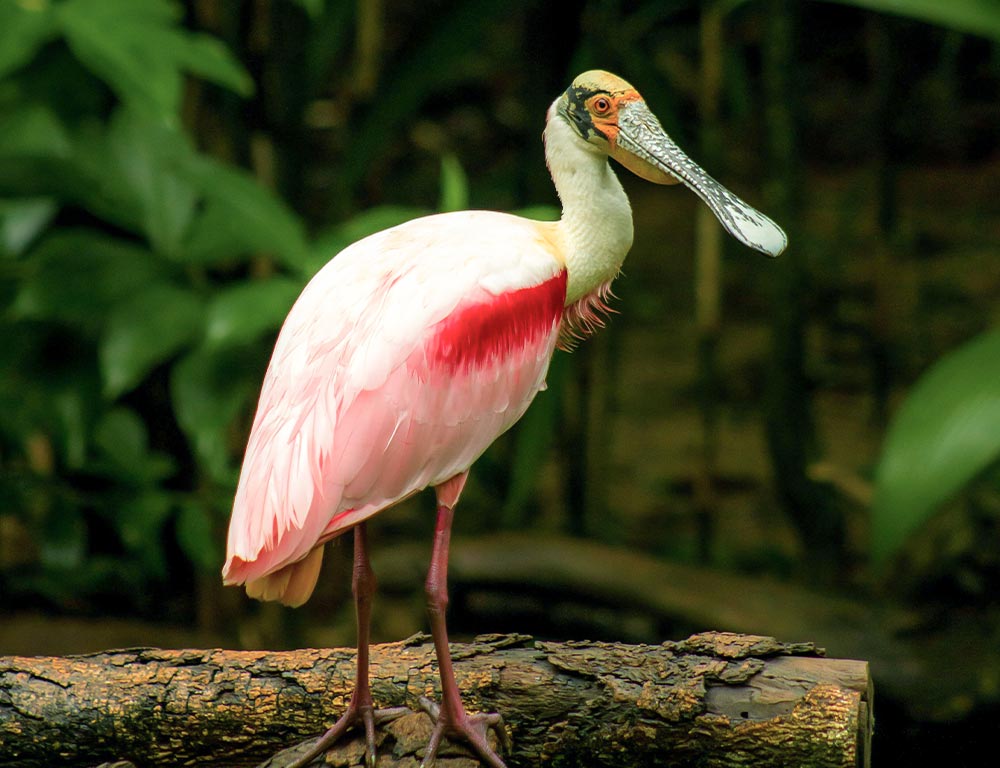
- Scientific Name: Platalea ajaja
- Category: Wading Bird
- Population: Generally stable, but specific regions may face threats.
- Life Span: Approximately 10-15 years.
- Size: Typically 70 to 80 cm in length.
- Weight: Around 1.2 to 2.7 kg.
- Food: Feeds on small fish, crustaceans, and aquatic invertebrates.
- Wingspan: Around 120 to 130 cm.
- Status: Generally not of concern.
The Roseate Spoonbill, scientifically known as Platalea ajaja, is a vibrant wading bird primarily found in the Americas, from the southeastern United States to South America.
Recognizable by its rosy plumage and distinctive spoon-shaped bill, this species enjoys a generally stable population, although certain regions may face threats.
With a lifespan of approximately 10 to 15 years, Roseate Spoonbills typically measure between 70 to 80 cm, weighing around 1.2 to 2.7 kg.
These birds are skilled foragers, using their unique bills to capture small fish, crustaceans, and aquatic invertebrates in shallow waters. Their wingspan, ranging from 120 to 130 cm, allows for graceful flight across a variety of wetland habitats.
Overall, Roseate Spoonbills contribute to the biodiversity of their ecosystems, adding a splash of color and elegance with their vibrant appearance and feeding behaviors.
Wrapping Up
In exploring the diverse world of spoonbills, from the enchanting Yellow-Billed Spoonbill to the regal Royal Spoonbill and the vibrant Roseate Spoonbill, we’ve uncovered a tapestry of avian diversity.
These wading birds, adorned with distinctive spoon-shaped bills, contribute not only to the aesthetic richness of their habitats but also play crucial roles in maintaining ecological balance.
From Australia to the Americas, their adaptability and unique foraging behaviors underscore their resilience.
While some spoonbill species face conservation challenges, others thrive with stable populations. The regional nuances in their statuses highlight the need for targeted conservation efforts.
From their efficient foraging techniques to their graceful flight, each spoonbill species brings a unique charm to the wetlands they call home.